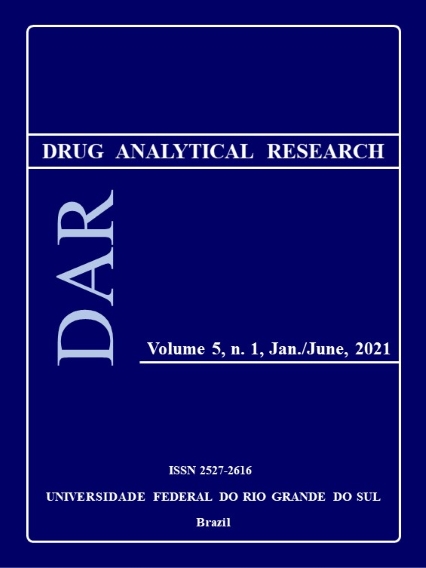A new and ecological miniaturized method by spectrophotometry for quantification of vancomycin in dosage form
DOI:
https://doi.org/10.22456/2527-2616.112226Abstract
Vancomycin, an important antibiotic, is marketed as lyophilized powder. In the context of routine analysis of this product, the existence of a more advantageous and effective method is interesting. Thus, the objective of this work is to develop and validate a new analytical method, faster, low-cost, ecological and miniaturized for quantification of vancomycin in lyophilized powder using spectrophotometry in ultraviolet region. Buffer solution pH 6.8, quartz cuvette with capacity of 700 µL and 280 nm were chosen. The method proved to be linear in the range of 50-150 µg/mL (0.9997). The selectivity of the method was proven in two ways: The standard-sample overlay aimed to identify vancomycin in the sample; The forced degradation test (sample solutions prepared in 0.01 M HCl, 0.01 M NaOH and aqueous conditions and kept at 60 ºC by 8 hours, and UV 254 nm at ambient temperature during 24 hours) aimed to show the susceptibility of the method to consequently indicate the stability of the sample. It was precise in intraday (RSD 1.27%), interday (RSD 1.18%) and between analysts (RSD 1.92%) levels. It was robust when small variations were performed in seven important parameters (wavelength, cuvette, filtration step, dibasic and monobasic phosphate brand, ultrasound time and source of water). The accuracy was proved by the standard recovery test and showed mean recovery of 101.10%. This method can be applied in routine analysis of quality control of vancomycin lyophilized powder and it is an effective, accessible and ecological alternative, which follows the Green Analytical Chemistry principles, presenting less waste generation, no use of toxic solvents, smaller sample volumes and required diluents, which impacts on the final cost of the analyzes.
Downloads
Downloads
Published
How to Cite
Issue
Section
License
The Copyright holder of manuscripts published is Drug Analytical Research. Authors who publish with this journal are able to enter into separate, additional contractual arrangements for the non-exclusive distribution of the journal's published version of the work (e.g., post it to an institutional repository or publish it in a book), with an acknowledgement of its initial publication in this journal.
Licensing:
Creative Commons Attribution-NonCommercial-ShareAlike 4.0 International License
Users are allowed to read, download, copy, distribute, print, search, or link to the full texts of the articles, or use them for any other lawful purpose, without asking prior permission from the publisher or the author.


